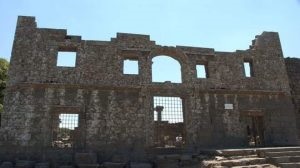Archaeological palaces in Qanawat … a unique architectural model and a living witness to the ancient civilization
Al-Sweida, (ST)- Archaeological palaces in the town of Qanawat in the city of al-Sweida are considered the most extensive monuments of the town and one of the most prominent archaeological evidence till our days. The height of its original facade is still as it was in ancient times.
The palaces include several important overlapping religious buildings ( like temples) that go back to successive eras and extend to the west, including a wide square which confined between the gates of the ancient city and the palaces. Most likely it was the city’s market at that time.
 The head of the Department of al-Sweida Antiquities , Dr. Nashaat Kiwan, told SANA that these archeological buildings include a temple from the Roman era that dates back to the second century AD, in which a church was built in the fourth century AD .Then a larger church was built in the fourth and fifth centuries AD, which includes a front hall and main reception hall.
The head of the Department of al-Sweida Antiquities , Dr. Nashaat Kiwan, told SANA that these archeological buildings include a temple from the Roman era that dates back to the second century AD, in which a church was built in the fourth century AD .Then a larger church was built in the fourth and fifth centuries AD, which includes a front hall and main reception hall.
Kiwan indicates that there were ruins of the church that was erected in the middle of the temple which has beautiful western facade and a garden with many large windows. He added that behind these archaeological ruins we find the remains of a temple and a church and then a wide corridor.
The town of Qanawat includes a number of archaeological sites that are still witnesses of its ancient history, most notably the archaeological water tank located to the southwest of the Palaces, the Temple of Zeus, the Qanawat theater, the Goddess of water, towers, tombs, and the Temple of the God of Sun.
M.Wassouf

